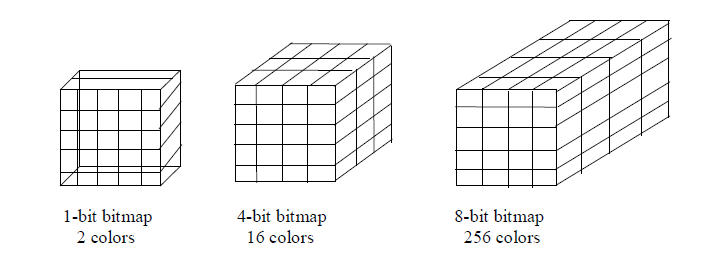A bitmap is a simple information matrix describing the individual dots that are the smallest elements of resolution on a computer screen or other display or printing device. A one-dimensional matrix is required for monochrome (black and white); greater depth (more bits of information) is required to describe more than 16 million colors the picture elements may have, as illustrated in following figure. The state of all the pixels on a computer screen make up the image seen by the viewer, whether in combinations of black and white or colored pixels in a line of text, a photograph-like picture, or a simple background pattern.
Where do bitmap come from? How are they made?
• Make a bitmap from scratch with paint or drawing program.
• Grab a bitmap from an active computer screen with a screen capture program, and then paste into a paint program or your application.
• Capture a bitmap from a photo, artwork, or a television image using a scanner or video capture device that digitizes the image.
Once made, a bitmap can be copied, altered, e-mailed, and otherwise used in many creative ways.
Clip Art
A clip art collection may contain a random assortment of images, or it may contain a series of graphics, photographs, sound, and video related to a single topic. For example, Corel, Micrografx, and Fractal Design bundle extensive clip art collection with their image-editing software.

Multiple Monitors
When developing multimedia, it is helpful to have more than one monitor, or a single high-resolution monitor with lots of screen real estate, hooked up to your computer. In this way, you can display the full-screen working area of your project or presentation and still have space to put your tools and other menus. This is particularly important in an authoring system such as Macromedia Director, where the edits and changes you make in one window are immediately visible in the presentation window-provided the presentation window is not obscured by your editing tools.



